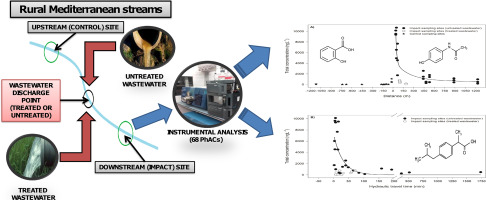当前位置:
X-MOL 学术
›
Sci. Total Environ.
›
论文详情
Our official English website, www.x-mol.net, welcomes your
feedback! (Note: you will need to create a separate account there.)
Impact of urban chemical pollution on water quality in small, rural and effluent-dominated Mediterranean streams and rivers
Science of the Total Environment ( IF 8.2 ) Pub Date : 2017-09-20 , DOI: 10.1016/j.scitotenv.2017.09.128 Ladislav Mandaric , Jordi-René Mor , Sergi Sabater , Mira Petrovic
Science of the Total Environment ( IF 8.2 ) Pub Date : 2017-09-20 , DOI: 10.1016/j.scitotenv.2017.09.128 Ladislav Mandaric , Jordi-René Mor , Sergi Sabater , Mira Petrovic

|
The impact and occurrence of wastewater (treated and untreated) derived pharmaceutically active compounds (PhACs) have been investigated in small, rural and effluent-dominated tributaries of the lower Ebro River located in the North-Eastern Spain (Catalonia). We have observed the predominant effect of stream flow and consequently dilution factor on the concentration levels of detected PhACs that combined with the absence of wastewater treatment plants (WWTP) resulted in 12 times higher concentrations in streams with direct discharge of untreated wastewater. Non-steroidal anti-inflammatory drugs (NSAIDs) were the most ubiquitous compounds, in terms of both individual concentration and frequency of detection. In the sites impacted by raw wastewater, acetaminophen and ibuprofen showed the highest concentrations among all analyzed PhACs, reaching concentrations up to 7.78 μg L− 1 and 2.66 μg L− 1, respectively. However, PhACs detected in the sites impacted by treated wastewater showed generally lower concentration levels and frequencies of detection. Also, effluent-dominated streams showed higher concentration levels of PhACs due to a generally lower stream flows and small dilution factors. However, concentration levels of detected PhACs were dependent on the hydraulic travel time and distance from the discharge point and related with the in-stream attenuation. As a result, this study highlights the combined impact of hydrological and chemical stressors on the water quality of the rural Mediterranean aquatic ecosystems.
中文翻译:

城市化学污染对小型,农村和以废水为主的地中海河流和河流水质的影响
在西班牙东北部(加泰罗尼亚)的下埃布罗河的小型,农村和以废水为主的支流中,已经研究了废水(处理过的和未处理过的)药物活性化合物(PhACs)的影响和发生。我们已经观察到了水流的主要影响,因此稀释因子对检测到的PhAC的浓度水平产生了显着影响,再加上没有废水处理厂(WWTP)的存在,直接排放未经处理的废水所产生的水流浓度提高了12倍。就个体浓度和检测频率而言,非甾体类抗炎药(NSAIDs)是最普遍使用的化合物。在受原始废水影响的地点,对乙酰氨基酚和布洛芬的浓度在所有分析的PhAC中最高,-1和2.66μgL -1。但是,在受处理废水影响的站点中检测到的PhAC通常显示较低的浓度水平和检测频率。同样,由于通常较低的物流流量和较小的稀释因子,污水为主的物流显示出较高的PhAC浓度水平。但是,检测到的PhAC的浓度水平取决于水力行进时间和距排放点的距离,并与流内衰减相关。结果,本研究强调了水文和化学胁迫因素对地中海乡村水生生态系统水质的综合影响。
更新日期:2017-09-21
中文翻译:

城市化学污染对小型,农村和以废水为主的地中海河流和河流水质的影响
在西班牙东北部(加泰罗尼亚)的下埃布罗河的小型,农村和以废水为主的支流中,已经研究了废水(处理过的和未处理过的)药物活性化合物(PhACs)的影响和发生。我们已经观察到了水流的主要影响,因此稀释因子对检测到的PhAC的浓度水平产生了显着影响,再加上没有废水处理厂(WWTP)的存在,直接排放未经处理的废水所产生的水流浓度提高了12倍。就个体浓度和检测频率而言,非甾体类抗炎药(NSAIDs)是最普遍使用的化合物。在受原始废水影响的地点,对乙酰氨基酚和布洛芬的浓度在所有分析的PhAC中最高,-1和2.66μgL -1。但是,在受处理废水影响的站点中检测到的PhAC通常显示较低的浓度水平和检测频率。同样,由于通常较低的物流流量和较小的稀释因子,污水为主的物流显示出较高的PhAC浓度水平。但是,检测到的PhAC的浓度水平取决于水力行进时间和距排放点的距离,并与流内衰减相关。结果,本研究强调了水文和化学胁迫因素对地中海乡村水生生态系统水质的综合影响。











































 京公网安备 11010802027423号
京公网安备 11010802027423号